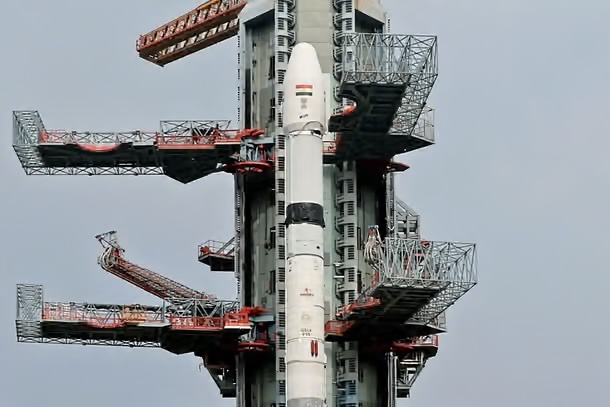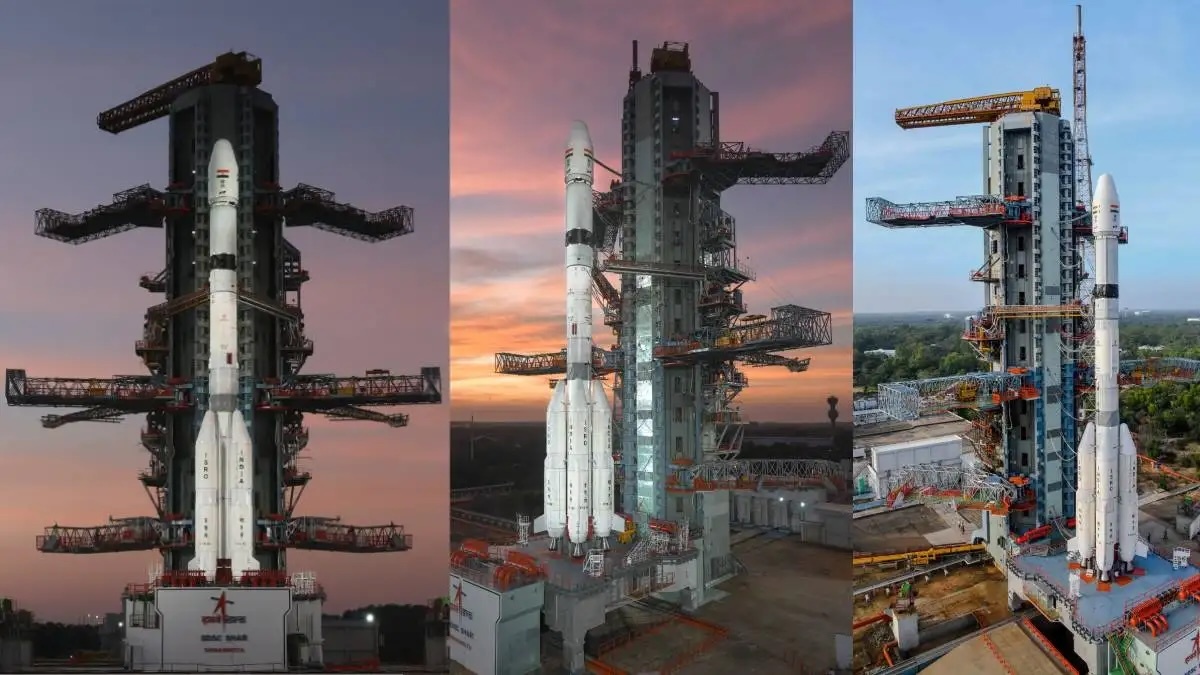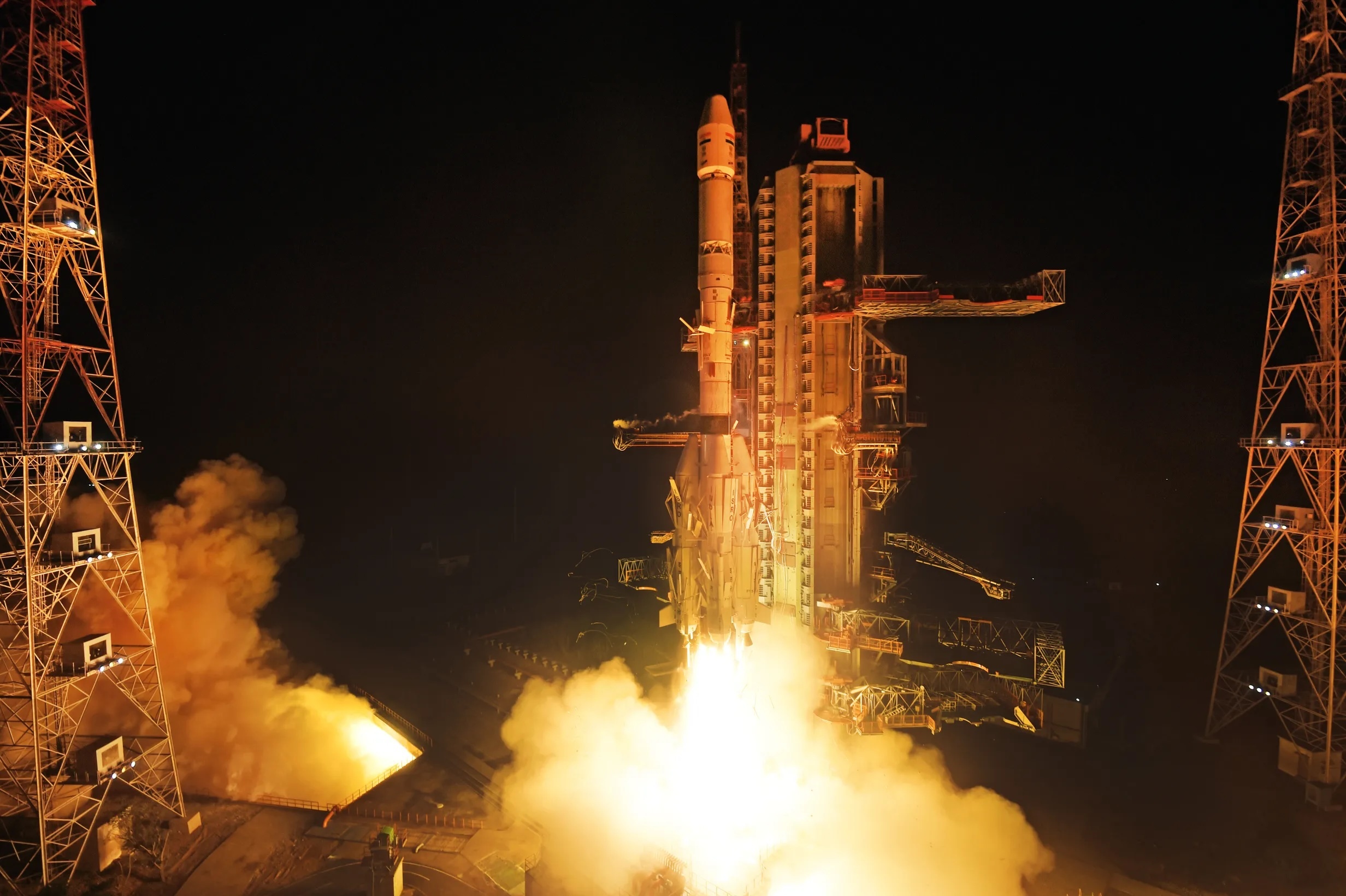25.01.2025
ISRO Set To Launch NVS-02 Satellite With Indigenous Atomic Clocks Onboard GSLV-F15 For Enhanced NavIC Services

The Indian Space Research Organisation (ISRO) has rolled out the Geosynchronous Satellite Launch Vehicle (GSLV) to the launchpad with the NVS-02 satellite, which is a part of the Navigation with Indian Constellation (NavIC) system.
Scheduled for 29 January, the GSLV-F15 mission will take off from the Second Launch Pad (SLP) at the Satish Dhawan Space Centre in Andhra Pradesh's Sriharikota.
It will deploy the NVS-02 satellite into a Geosynchronous Transfer Orbit, marking the eighth operational flight of the GSLV equipped with an indigenous Cryogenic stage and the 100th launch from India’s primary spaceport.
NVS-02 is the second satellite in India’s new generation of navigation satellites, part of the Navigation with Indian Constellation (NavIC) system.
NavIC, India’s regional satellite navigation system, delivers precise positioning, velocity, and timing data for users across the country and neighbouring regions, extending up to 1,500 km beyond India’s borders.
The NVS-02 satellite is set to enhance NavIC’s services, which are widely used for applications such as navigation, precision agriculture, emergency services, fleet management, and even mobile device location services.
It has an advanced navigation payload capable of operating on three frequency bands—L1, L5, and S—for high accuracy.
Equipped with the Rubidium Atomic Frequency Standard (RAFS), a precise atomic clock, NVS-02 will ensure accurate timekeeping.
Positioned at 111.75 degree East, the satellite will replace the older IRNSS-1E satellite.
With a weight of 2,250 kg and a power capacity of 3 kW, it incorporates both indigenous and imported atomic clocks.
The inclusion of the new L1 band signals enhances NavIC’s compatibility with global navigation systems, promoting broader adoption and improved service quality.
The NVS-02 satellite has been designed, developed, and integrated at the U R Satellite Centre (URSC).
Quelle: swarajyamag.com
----
Update: 28.01.2025
.
ISRO all set to launch its historic 100th mission, countdown underway at Sriharikota
ISRO's 100th mission is scheduled to launch at 6:23 AM on January 29. The mission aims to launch a second-generation NavIC satellite in the base layer.

isro-gslv-f15-ready-for-launch-1738053551
The 27-hour countdown began on Tuesday for ISRO's historic 100th mission, which involves the launch of a navigation satellite aboard a GSLV rocket, according to sources within the space agency. This mission marks the first for ISRO Chairman V Narayanan, who took office on January 13.
The Geosynchronous Satellite Launch Vehicle (GSLV), featuring an indigenous cryogenic upper stage in its 17th flight, is set to launch the navigation satellite NVS-02 at 6:23 AM on January 29 from the second launch pad at the spaceport.
The satellite is the second in the Navigation with Indian Constellation (NavIC) series, designed to provide accurate position, velocity, and timing information to users across the Indian subcontinent and extending up to 1,500 km beyond India's borders.
Multiple sources indicated to PTI that the countdown officially commenced at 2:53 AM on Tuesday. Standing 50.9 meters tall, the GSLV-F15 follows the successful GSLV-F12 mission, which launched the NVS-01 satellite, the first of the second-generation satellites, on May 29, 2023.
NavIC consists of five second-generation satellites, namely NVS-01, NVS-02, NVS-03, NVS-04, and NVS-05, which are intended to enhance the existing NavIC base layer constellation and ensure continuity of services.
The NVS-02 satellite, designed and developed by the U R Satellite Centre, weighs approximately 2,250 kg and is equipped with navigation payloads in L1, L5, and S bands, as well as a ranging payload in C-band, similar to its predecessor NVS-01.
ISRO stated that the satellite's key applications would include terrestrial, aerial, and maritime navigation, precision agriculture, fleet management, location-based services for mobile devices, orbit determination for satellites, IoT-based applications, and providing emergency and timing services.
In other news, the Maha Kumbh Mela, noted as the world's largest religious gathering, was recently photographed from the International Space Station (ISS). Officials announced that these images were shared by NASA astronaut Don Pettit on the social media platform X. Taken on Sunday, the images show the illuminated banks of the Ganges River, highlighting the event's notable activity.
Quelle: INDIA TV
----
Update: 29.01.2025
.
India’s first launch of 2025 sends NVS-02 navigation satellite into orbit

The GSLV Mk II F15 lifts off from from the Satish Dhawan Space Centre, Jan. 29 (UTC), carrying the NVS-02 satellite. Credit: ISRO
HELSINKI — India conducted its first launch of the year late Tuesday, sending a new-generation navigation satellite towards geostationary orbit.
A Geosynchronous Satellite Launch Vehicle (GSLV) Mk II lifted off at 7:53 p.m. Eastern (0053 UTC) from Satish Dhawan Space Centre. Aboard was the NVS-02 satellite, sent into geosynchronous transfer orbit. The satellite is the second of five new-generation spacecraft for the Navigation with Indian Constellation (NavIC). NVS-01 launched in 2023.
“I am extremely happy to announce from the spaceport of ISRO that the first launch of this year, 2025, has been successfully accomplished, with the GSLV F15 launch vehicle precisely injecting the navigation satellite NVS-02 in the required intended orbit,” new ISRO chairman V. Narayanan said, confirming launch success.
The independent NavIC system is designed to provide accurate real-time positioning, velocity and timing services to India and surrounding areas. NavIC provides a Standard Positioning Service (SPS) for public use and a Restricted Service (RS) for military and strategic applications.
The 2,250-kilogram NVS-02 will be placed at 111.75 degrees East, replacing IRNSS-1E, launched in 2016. The satellite uses a combination of indigenous and procured atomic clocks for precise time estimation, according to the Indian Space Research Organisation (ISRO). The GSLV launcher is a three-stage vehicle with solid, liquid and cryogenic stages and four liquid boosters.
The mission was the first of 10 orbital launches planned by India in 2025, which would mark a domestic launch record. Major missions include a joint Earth science mission between NASA and ISRO, named NASA-ISRO Synthetic Aperture Radar (NISAR), expected to launch around March on a GSLV rocket, and an uncrewed test flight for Gaganyaan human spaceflight program on a human-rated LVM-3 launcher. The first launch of the Vikram-1 for private company Skyroot Aerospace could also take place this year.
Tuesday’s mission was the 100th launch from the spaceport on Sriharikota, a barrier island off the Bay of Bengal on India’s southeastern coast. The first launch from Satish Dhawan Space Centre took place in August 1979.
ISRO officials expressed confidence in accelerating the launch cadence, with Vikram Sarabhai Space Centre Director S. Unnikrishnan Nair stating, “I am sure we can achieve the 200th mark faster because of the vibrant ecosystem.”
Earlier this month India’s cabinet approved the establishment of a third launch pad at Satish Dhawan Space Centre for a Next Generation Launch Vehicle (NGLV).
India’s space ambitions include becoming only the fourth country to develop independent human spaceflight capabilities. Beyond this, the country aims to construct the Bharatiya Antariksha Station (Indian Space Station) by 2035, and conduct a crewed moon landing by 2040.
ISRO successfully conducted an on-orbit docking test Jan. 16 using two Space Docking Experiment (SpaDeX) spacecraft. The accomplishment is a step forward for India’s human spaceflight plans and further missions such as the Chandrayaan-4 lunar south pole sample return mission.

